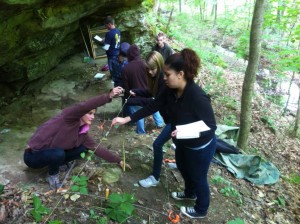Ellie Koewler ’15
Senior Anthropology and Geology student Lauren Johnson has unearthed some ideas about how Native Americans might have lived—just down the road from where Ohio University now sits.
She has spent nearly two years excavating artifacts and researching geological data from a nearby rock shelter with Dr. Paul Patton, Assistant Professor of Anthropology.
Ohio residents as far back as the Late Prehistoric period had to deal with climate change and environmental instability, the two suggest. And the rock shelter they are excavating was likely used when local residents foraged for food to supplement their struggling maize crops.
Following Up with Independent Research
During Summer 2013, Johnson participated in OHIO’s Field School in Ohio Archaeology (ANTH 4911), where she and other students excavated a nearby rock shelter over a 10-week period. Once they were done excavating, they spent another two weeks analyzing artifacts in the lab as a class.
Upon completion of the field school, Johnson decided to continue independent research on the site in order to piece together the class analysis and develop a hypothesis about the function of the site.
“I’ve always loved being outside. The field school was an opportunity to combine my enthusiasm for working outside with my endless desire to learn,” she says. “I also thought it was really cool that the cave was in the local area. The Hocking Valley has a very interesting archaeological record” that can be explored more in-depth to provide clues to the history of prehistoric peoples that once inhabited the region.
Johnson spent hours in the lab with the recovered artifacts and looking over site maps. It soon became evident that the clustering of specific artifacts suggests certain areas of the rock shelter were designated for specific activities. In addition, she used climatic data analyzed by a former Ohio University graduate student, Staci Spertzel (MSES), that indicated there was a period of environmental instability during the Late Prehistoric period, the time in which the rock shelter would have been inhabited. Drops in precipitation during this period would have challenged the maize-based economy of the period.
A Working Hypothesis
Johnson and Patton have formulated a working hypothesis: During the Late Prehistoric period, the increase in exploitation of rock shelters in the Hocking Valley region was a strategic attempt to offset economic and dietary risks by supplementing agricultural production with foraged foods.
In October of 2013, Johnson presented the initial data at the Midwest Archaeological Conference. The support she received at the conference encouraged her to move forward. “I got great feedback from Patton’s network and got to talk about the discipline casually with professors and gain contacts,” she said.
Johnson is now in the final stages of writing a paper with Patton, which will be sent to a scholarly journal for review and publication.
“Lauren is an excellent student and researcher, who I think demonstrates how experiential learning combined with genuine curiosity promotes educational opportunities and scholarly accomplishment,” says Patton. “It has been extremely rewarding to watch her and advise her as she has developed from an interested student in the field to an independent and highly-capable young scientist.”
This summer, two more of Patton’s field school students are planning to present at national academic conferences. “I think one of the most important things we can do as faculty members is to provide students with hands-on methodological learning opportunities and then guide them through the process of turning those experiences into real research and scientific knowledge,” says Patton.
“To have field work under your belt really gives you a leg up,” adds Johnson. “It immerses you in the subject and gives you the opportunity to see if you like working in a hands-on environment as opposed to a strictly academic one. Conducting further research has enabled me to get to know many professors in the department. I have already received so much support and advice about post-graduation from faculty members. This work is an asset to furthering my career and I am so thankful for the opportunity.”




















Comments